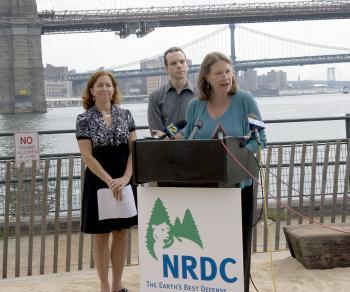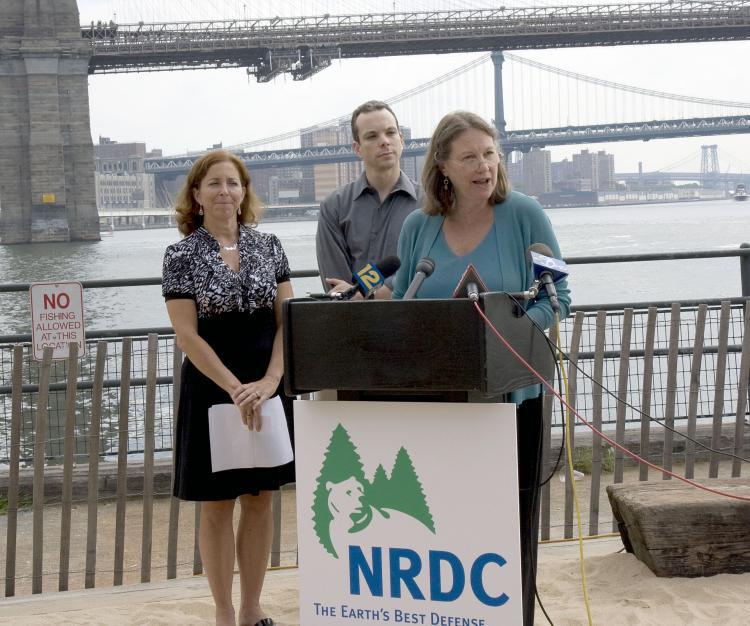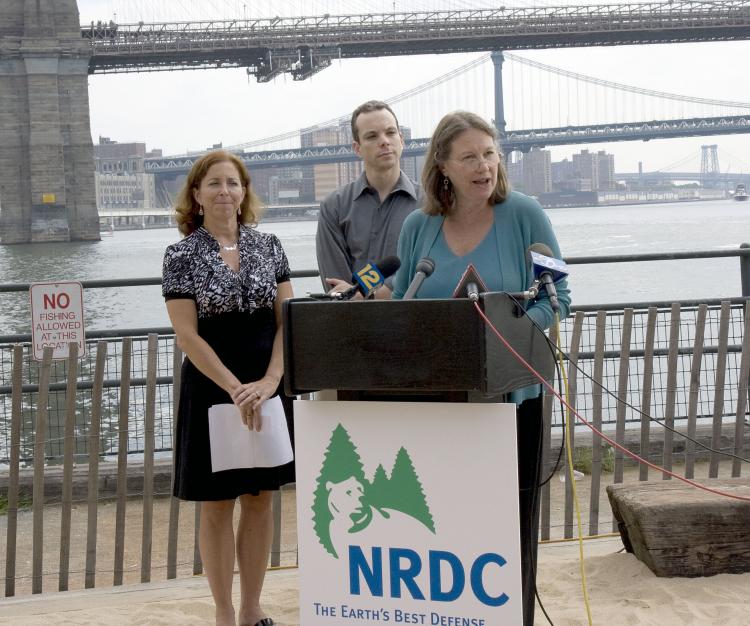NEW YORK—The National Resources Defense Council (NRDC) released its 20th annual “Testing the Waters” report on beachwater quality on Wednesday, revealing New York’s position at 23rd out of the 30 coastal states tested, or the nation’s seventh worst. The states were ranked by the percentage of beachwater samples that exceeded federal health standards.
In 2009, there were 1,775 beach closing and advisory days in New York, up 10 percent from 2008. Seventy-six percent of these closings and advisories were caused by stormwater runoff. This increase can be attributed to New York’s unusually high precipitation last year.
In New York, the beach with the highest percentage of samples exceeding state standards for daily maximum bacterial levels in 2009 was Krull Park of Niagara County in upstate New York (57 percent). Statewide, of all reported beach monitoring samples from a total of 314 beaches, 11 percent exceeded standards.
In the city, Orchard Beach in the Bronx and Manhattan Beach in Brooklyn experienced the biggest jump in exceeding levels from 2008 to 2009, and are also the dirtiest public beaches in the city. Senior attorney for NRDC, Lawrence Levin cited a jump from 2 percent to 12 percent in Orchard Beach, while Manhattan Beach went from 3 to 14 percent.
In addition, the city’s public beaches had 25 closing and advisory days in 2009, compared to 10 in 2008. This increase was due to a sewage spill at the Coney Island Sewage Treatment Plant that contaminated waters in Coney Island Beach and Manhattan Beach, Levin explained.
Meanwhile, Staten Island’s beaches had no closures and only one beachwater sample exceeded health standards. On the other hand, small private beaches in northern Queens and the Bronx are the city’s dirtiest, which Levin explains may be due to their tendency to be close to pollution sources, like sewage plants and boats that spew oil residue.
Levin also stated that there are fundamental problems with New York City’s stormwater management system. “The city routinely dumps untreated sewage into the city’s waters from 450 locations in all five boroughs. These raw sewage releases are called combine sewage overflows. … Every time it rains here, rainwater flows into the same pipes that carry wastewater from homes and buildings. When the water level is more than municipal sewage treatment plants can handle, it flows straight into our waterways untreated.” The amount of untreated sewage can amount to 27 billion gallons a year.
This is especially problematic when most of the city’s waterways are used by the public for various recreational activities, including fishing, swimming, and kayaking, and can come into contact with dirty water.
NRDC’s report also includes a five-star rating system for the most popular beaches in the nation. None of the beaches in New York or New Jersey earned a rating of more than three stars because they failed to monitor water samples more than once a week, and did not issue prompt advisories to the public after finding exceedances in samples. Typically, once an exceedance is found, the results are verified through a retest before the public is ever notified. The retesting can take up to 24 hours, and NRDC believes that by then, it is too late.
“Because of the tremendous economic value that’s generated by recreation and tourism, we think that this is a critical function that the government has to play in terms of really making sure that the public can go to the beach and can rest assured that when they swim in the water, they’re not going to get sick,” said Sarah Chasis, director of NRDC’s Oceans Initiative.
The NRDC suggested “green infrastructure” as the easiest, most cost-effective solution to the problem of water pollution. As stormwater runoff is the largest known source of beachwater contamination, porous surfaces and retention devices should be used to store the rainwater or allow it to soak back into the ground. Runoff can then be naturally filtered back into the ground while also recharging groundwater supplies, Levin noted. Solutions include permeable pavement, green roofs, roadside planting and rain barrels.
Adrienne Esposito, executive director of the Citizens Campaign for the Environment based in Long Island, urged government officials nationwide to incorporate these inexpensive solutions into municipal planning codes. “Now we want to take all those hard years of effort and turn it into public policy so we can say our beaches are clean, our beaches are open, our beaches are safe. That’s what the public wants, that’s what the public deserves, and frankly, that’s what our tax dollars should be paying for.”
Esposito also addressed the poor beachwater quality in Long Island beaches, where the Centerport Yacht Club in Centerport, New York was closed for the entire season (107 days) due to high bacterial levels.
Nationally, 7 percent of all beachwater samples violated health standards, which showed no improvement from the last two years.
In light of the recent oil spill disaster in the Gulf of Mexico, this year’s report includes a special section on Gulf shorelines that have been affected by the spill. As of July 27, there have been 2,239 beach closures and advisoriy days in the Gulf region.
In 2009, there were 1,775 beach closing and advisory days in New York, up 10 percent from 2008. Seventy-six percent of these closings and advisories were caused by stormwater runoff. This increase can be attributed to New York’s unusually high precipitation last year.
In New York, the beach with the highest percentage of samples exceeding state standards for daily maximum bacterial levels in 2009 was Krull Park of Niagara County in upstate New York (57 percent). Statewide, of all reported beach monitoring samples from a total of 314 beaches, 11 percent exceeded standards.
In the city, Orchard Beach in the Bronx and Manhattan Beach in Brooklyn experienced the biggest jump in exceeding levels from 2008 to 2009, and are also the dirtiest public beaches in the city. Senior attorney for NRDC, Lawrence Levin cited a jump from 2 percent to 12 percent in Orchard Beach, while Manhattan Beach went from 3 to 14 percent.
In addition, the city’s public beaches had 25 closing and advisory days in 2009, compared to 10 in 2008. This increase was due to a sewage spill at the Coney Island Sewage Treatment Plant that contaminated waters in Coney Island Beach and Manhattan Beach, Levin explained.
Meanwhile, Staten Island’s beaches had no closures and only one beachwater sample exceeded health standards. On the other hand, small private beaches in northern Queens and the Bronx are the city’s dirtiest, which Levin explains may be due to their tendency to be close to pollution sources, like sewage plants and boats that spew oil residue.
Levin also stated that there are fundamental problems with New York City’s stormwater management system. “The city routinely dumps untreated sewage into the city’s waters from 450 locations in all five boroughs. These raw sewage releases are called combine sewage overflows. … Every time it rains here, rainwater flows into the same pipes that carry wastewater from homes and buildings. When the water level is more than municipal sewage treatment plants can handle, it flows straight into our waterways untreated.” The amount of untreated sewage can amount to 27 billion gallons a year.
This is especially problematic when most of the city’s waterways are used by the public for various recreational activities, including fishing, swimming, and kayaking, and can come into contact with dirty water.
NRDC’s report also includes a five-star rating system for the most popular beaches in the nation. None of the beaches in New York or New Jersey earned a rating of more than three stars because they failed to monitor water samples more than once a week, and did not issue prompt advisories to the public after finding exceedances in samples. Typically, once an exceedance is found, the results are verified through a retest before the public is ever notified. The retesting can take up to 24 hours, and NRDC believes that by then, it is too late.
“Because of the tremendous economic value that’s generated by recreation and tourism, we think that this is a critical function that the government has to play in terms of really making sure that the public can go to the beach and can rest assured that when they swim in the water, they’re not going to get sick,” said Sarah Chasis, director of NRDC’s Oceans Initiative.
The NRDC suggested “green infrastructure” as the easiest, most cost-effective solution to the problem of water pollution. As stormwater runoff is the largest known source of beachwater contamination, porous surfaces and retention devices should be used to store the rainwater or allow it to soak back into the ground. Runoff can then be naturally filtered back into the ground while also recharging groundwater supplies, Levin noted. Solutions include permeable pavement, green roofs, roadside planting and rain barrels.
Adrienne Esposito, executive director of the Citizens Campaign for the Environment based in Long Island, urged government officials nationwide to incorporate these inexpensive solutions into municipal planning codes. “Now we want to take all those hard years of effort and turn it into public policy so we can say our beaches are clean, our beaches are open, our beaches are safe. That’s what the public wants, that’s what the public deserves, and frankly, that’s what our tax dollars should be paying for.”
Esposito also addressed the poor beachwater quality in Long Island beaches, where the Centerport Yacht Club in Centerport, New York was closed for the entire season (107 days) due to high bacterial levels.
Nationally, 7 percent of all beachwater samples violated health standards, which showed no improvement from the last two years.
In light of the recent oil spill disaster in the Gulf of Mexico, this year’s report includes a special section on Gulf shorelines that have been affected by the spill. As of July 27, there have been 2,239 beach closures and advisoriy days in the Gulf region.







